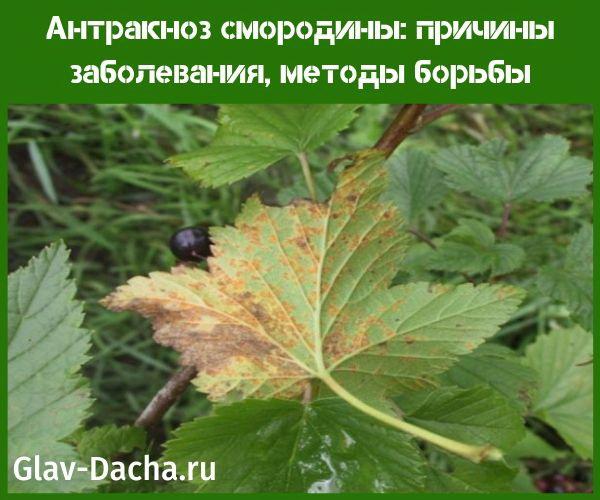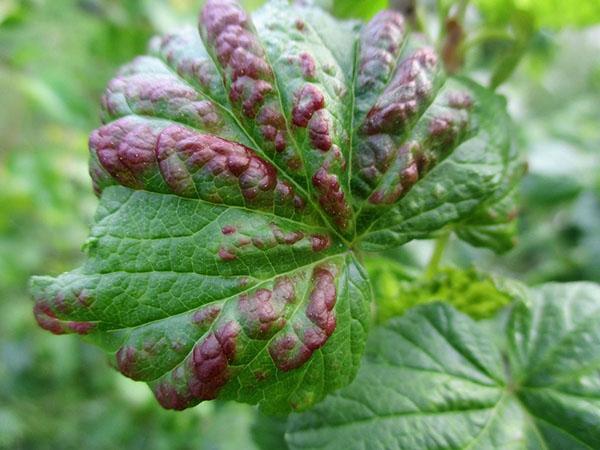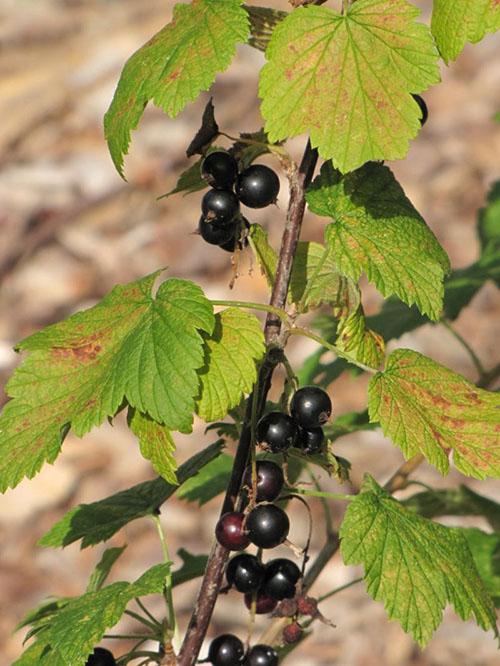Currant anthracnose: causes of the disease, methods of struggle
 Currant anthracnose is a fairly common problem. If steps are not taken to heal, the shrub will die and the infection will spread to other plants. Therefore, it is very important to determine the disease in time. This is the only way to grow a beautiful bush on your site, which will delight you with abundant fruiting.
Currant anthracnose is a fairly common problem. If steps are not taken to heal, the shrub will die and the infection will spread to other plants. Therefore, it is very important to determine the disease in time. This is the only way to grow a beautiful bush on your site, which will delight you with abundant fruiting.
For what reasons does currant anthracnose appear?


You can recognize an infection by the following signs:
- Leaves are the first to suffer. They are covered with spots with a yellow or dark border, their middle is brown with a red tint. Over time, they grow in size and connect.
- On the twigs, depressed areas form. Such damage makes it difficult for moisture and nutrients to move through them.
- At first, not very large spots grow and change color, become dark brown, the border - purple.
- If the weather is dry, then the stem and foliage with spots crack, with high humidity rot develops.
- Over time, all the foliage turns brown, curls upward, flies around, and the bush dies. Bare branches will be in the middle of summer.
- If the plant is sick with anthracnose, then in the spring it slowly grows, there are many branches on it that are frozen, dried up.
The most unfavorable conditions for a plant are a humidity of about 90% and a temperature of 22 ° C. In this case, the fungus grows with lightning speed.
Increased acidity of the soil, a small amount of phosphorus, potassium compounds contribute to the spread of the disease. More often weakened bushes, with cuts on the bark, cracks are ill. The first signs of the disease can be noticed as early as May, as soon as the weather is warm. The disease manifests itself more strongly during a rainy summer.
Currant anthracnose: drug treatment
 The main condition for successful treatment is to destroy the foci of infection. Therefore, all cut branches and fallen leaves, any plant residues in the fall must be burned.
The main condition for successful treatment is to destroy the foci of infection. Therefore, all cut branches and fallen leaves, any plant residues in the fall must be burned.
Of chemical preparations, good results are obtained:
- Nitrafen at a concentration of 3% or DNOC at a concentration of 1%. It is advisable to use them for the autumn processing of currant bushes and the land around them twice a season: in the fall and at the beginning of spring, while the buds are just swelling.
- Kaptan, Tsineb or bordeaux liquid also effective in preventing disease. They are used to process berry bushes after they have faded. The plants are processed a second time about 2 weeks after the harvest.
- For the treatment of bushes, fungicides are suitable: colloidal sulfur, Tiovit Jet. Can also be used for Cumulufus-DF currants.
- If the bush gets sick during the harvest period, then more gentle and safe means are used. For example, Fitosporin.
It is better to plant in the summer cottage those varieties and varieties of currants that are not inclined to get sick with anthracnose. Black currant generally less of this disease than red.
Treatment with folk remedies
 Plants tend to get used to a single drug, resulting in reduced effectiveness.
Plants tend to get used to a single drug, resulting in reduced effectiveness.
Therefore, you can alternate chemical treatment with such folk remedies:
- Boiling water. The fungus is a living organism that cannot stand high temperatures. A rather radical, but effective method is to spray the shrub with water of about 70 ° C. You can process the plant with this method until the buds open, if later, the foliage will burn.
- Iodine. It kills infections of various natures. To process currants, you need to take warm water (a little warmer than room temperature), add only 1 drop of iodine to each liter.
- Laundry soap. It will help both against fungus and against harmful insects. Half a bar of laundry soap must be chopped (chopped, grated), dissolved in a bucket of water (10 l). Better to take lukewarm water. This makes the soap easier to dissolve.
Currant is not the most capricious culture, but sometimes anthracnose settles on it. It is necessary to treat the disease at the first symptoms, otherwise not only the harvest will be lost, but all the berry bushes. There are many chemicals and folk methods, they can be combined.